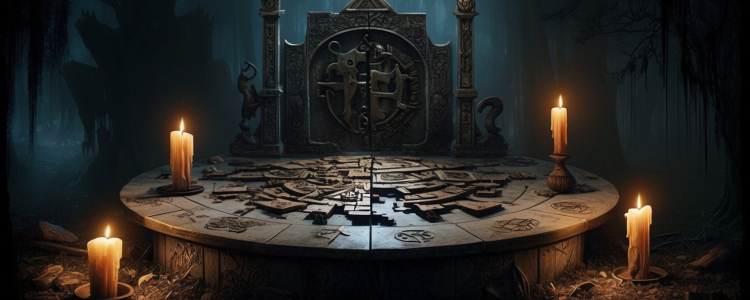Rituals of Mystery: Deconstructing the Altar Puzzle in Silent Hill f

The eerie world of Silent Hill f unravels before your eyes with a blend of unsettling ambience, intricate puzzles, and a legacy steeped in mystery. As you enter this dark realm, every interaction and detail is designed to immerse you in a narrative that pushes both your observational skills and your resolve. The journey through puzzles serves not only as a barrier to progression but also as a gateway into the philosophy and symbolism that have defined the series for decades. The altar puzzle, a seemingly simple yet deceptively layered challenge, sets the tone early in the game and demands a discerning eye to piece together clues that are both visual and poetic.
Exploring the Puzzle's Foundations
The foundation of the altar challenge lies in the careful arrangement of five distinct offerings placed upon corresponding stands. Early in Silent Hill f, the player is introduced to this puzzle which, while straightforward compared to later enigmas, still captivates with its blend of symbolism and mechanical interaction. At the altar, each item—ranging from a paper fan to ceremonial items adorned with enigmatic wrappings—is available for scrutiny. The designer's meticulous use of visual cues, such as matching symbols on both the offerings and their specific locations on the altar, invites the player into an exercise of observation and intuition. This challenge exemplifies the game’s design philosophy that integrates narrative lore with interactive problem-solving, crafting not just a barrier to progress but also a deeper engagement with the game’s thematic elements.
A Detailed Look at the Offerings
Each of the five offerings serving as the puzzle’s centerpiece is steeped in subtle detail and traditional cultural symbolism that further enriches the game’s world. For instance, the vase and the paper fan are not mere objects but representations of different aspects of tradition and artistic expression in the narrative's setting. The three items fashioned from dead animals, each wrapped in a ceremonial cloth and distinguished by symbols—a bird, a mouse, and a fish—invite the player to approach the puzzle from a multi-layered perspective. These items, when spun or interacted with, reveal hidden icons that correspond directly to symbols etched into the altar stands. This deliberate interconnection between object and platform pushes the player to pay attention to not only the visual design but also to the underlying lore that breathes life into these relics.
Intertwining Symbols and Narrative
The puzzle is not a random assortment of mechanical challenges but a carefully constructed narrative device that employs symbols to further the game’s mythos. Each symbol found on the individual offerings is echoed in the design of the corresponding altar stand, creating a deliberate symmetry that beckons methodical exploration. The matching process, which relies on the player’s ability to align the visual cues with the provided stands, embodies a subtle commentary on the need for alignment in spirit and thought—a recurring theme throughout Silent Hill f. As you transition from one offering to the next, the hidden narrative layers within the puzzle begin to emerge, reinforcing the idea that every element in Silent Hill f is imbued with a meaning beyond its immediate function. Here, gameplay intertwines seamlessly with storytelling, presenting a challenge that is equally engaging in its intellectual stimulation and entertainment.
Embracing the Inherent Ambiguity

One of the most intriguing aspects of silent puzzles in this installment is the inherent ambiguity present in every clue provided by the game. The altar’s accompanying poem, though cryptic, conveys sentiments about respect, ancestral reverence, and the cleansing of a restless soul. While the words seem to point toward a ritualistic alignment of items, their vagueness leaves much room for interpretation. In this way, Silent Hill f encourages players to look beyond literal instructions and engage with the subtext of the narrative. Each phrase, laced with symbolic weight, is interwoven with the acclaim for ancient traditions and ancestral homage, prompting players to consider how past errors and unhealed wounds can affect present endeavors. The result is a layered experience that rewards deeper contemplation and an appreciation for the game’s broader themes.
Mechanics Behind the Puzzle Interaction
From a gameplay perspective, the altar puzzle leverages intuitive mechanics that require the player to experiment with their environment. The interaction model—allowing each offering to be spun—serves as a subtle hint that the items are more than static objects within a scene. This mechanic is carefully designed to reinforce the notion of hidden layers beneath the surface of the game’s world. As you manipulate the items, the symbols they reveal become a navigational tool in solving the spatial puzzle. This deliberate design choice challenges the player to engage with the objects on a tactile level, encouraging a hands-on manipulation of the in-game world that is both satisfying and narratively enriching. The puzzle thus stands as "a clear demonstration of the game’s unwavering dedication to" blending traditional point-and-click adventure elements with modern interactive design.
Visual Aesthetics and Symbolic Beauty
The visual composition of the altar scene reflects the aesthetic ethos of Silent Hill f, encapsulating a blend of traditional motifs and eerie, unsettling modern disquiet. The altar itself, adorned with precise detailing in its stands and symbols, presents an atmospheric backdrop that heightens the sense of mystique. The ceremonial wrappings on the three animal offerings are rendered with intricate patterns that not only Elevate their visual allure while also functioning as conduits for the symbols essential to puzzle resolution. Coupled with dim lighting and a persistent fog that shrouds the environment, the scene communicates a palpable sense of foreboding and reverence. This carefully orchestrated visual presentation elevates the puzzle from a mere game mechanic to a piece of interactive art, wherein every element—from color choice to texture detail—plays a role in creating an immersive, haunting experience.
Interaction of Gameplay and Storytelling
The altar challenge in Silent Hill f serves as a prime example of how gameplay mechanics are intricately tied to storytelling. The ritualistic arrangement of offerings on matching stands is more than a test of observational skill; it is a narrative device that hints at underlying themes of sacrifice, reverence, and the balance between chaos and order. By requiring players to interact with each item—spinning them to reveal secret symbols—the game subtly reinforces the idea that every action carries consequence within its dark narrative arc. The interplay between touching the objects and seeing the resulting alignment of symbols enriches the plot and deepens the mystery, effectively inviting players to piece together not only the solution to the puzzle but also the broader lore of the world. This synthesis of mechanics and story is a hallmark of the game’s design, enhancing the overall experience through intertwined layers of challenge and meaning.
Deciphering the Poetic Clues
The puzzle’s accompanying verse might seem vague Initially, however, a more thorough inspection uncovers that it is steeped in allegory and thematic symbolism. The lines, which speak of a restless heart and the need for spiritual purification through offerings, are not merely decorative flourishes but rather integral components of the puzzle’s framework. They hint at the necessity of aligning the physical with the metaphysical—a crucial element that is mirrored by the matching of tangible symbols on the altar stands with those found on the objects. The cryptic language of the poem serves to deepen the enigma, requiring players to navigate a labyrinth of lexical nuance and cultural references, thereby engaging both their intellect and imagination. Each word, carefully chosen for its thematic resonance, enriches the overarching narrative, intertwining the puzzle's solution with the spiritual undertones that run throughout the game.
Strategic Observations in the Game World
The puzzle is designed to encourage a methodical exploration of the game’s world, rewarding players who invest time in observation. Beyond the immediate challenge of aligning offerings with their corresponding stands lies a game universe replete with hidden details and subtle cues that hint at further mysteries. As players progress, they are nudged to recall the importance of each item’s position and the symbolic significance interwoven within the world’s aesthetic framework. The strategic interplay of memory and attention to detail emphasizes exploration, prompting players to not only solve the present puzzle but also to look for similar patterns in future challenges. Every symbol and arrangement encountered along the journey contributes to a growing understanding of the game’s intricate network of clues, a meticulous design choice that underscores the importance of thorough examination in advancing through Silent Hill f.
Mapping the Puzzle's Sequential Logic
In Silent Hill f, the logical process behind the altar puzzle is a study in sequence and spatial reasoning. The initial design, presenting five offerings alongside five corresponding altar stands, encourages a trial-and-error method that ultimately leads to recognition of a patterned solution. From the paper fan to the vase and the trio of animal-related items (featuring a bird, mouse, and fish), each object is meant to be placed in a specific order as dictated by their unique symbols. The methodical alignment—placing the fan on the front left, the fish on the back left, the vase in the front middle, the bird on the back right, and the mouse on the front right—unfolds almost rhythmically as the symbols synchronize with their designated locations. This sequential logic not only provides immediate gratification by triggering a cutscene but also reinforces the importance of spatial organization in the game’s design, blending visual cues with methodical reasoning.
Engaging with the Puzzle's Legacy
The design of the Silent Hill f altar puzzle is steeped in the legacy of earlier installments, capturing echoes of traditional game design while forging a path of its own. Its roots in earlier puzzles, such as the shrine vault challenge or coded locker sequences, reflect the series’ longstanding commitment to merging horror with cerebral challenges. This puzzle, though appearing less formidable than its successors, carries with it an inherited complexity that rewards careful exploration and thoughtful deduction. The symbolic interplay and tactile interactions with the offerings imbue Consider this alternative: "the scene imbued with an unbroken thread of historical legacy.". As players engage with this early challenge, they aren't merely cracking a puzzle but are also connecting with a broader narrative tradition, one that emphasizes cryptic clues and ritualistic practices. This ongoing dialogue between past and present game design enriches the experience, inviting a layered appreciation for the art of puzzle crafting.






